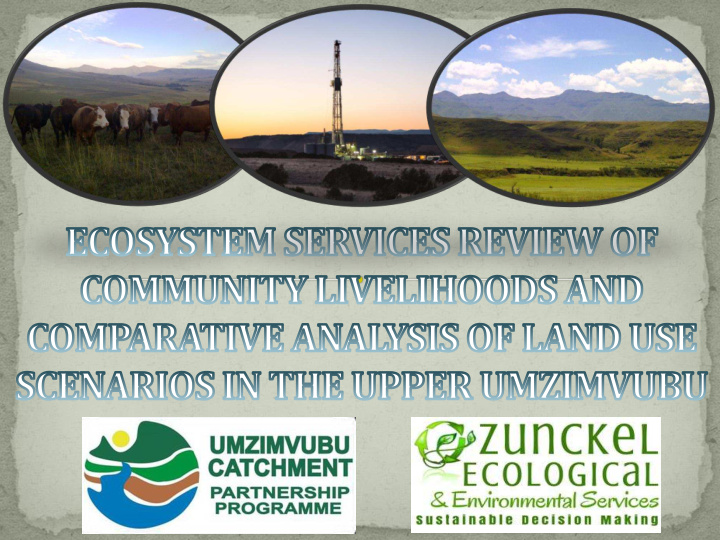



• Introductory comments re the context of the workshop • Ecosystem goods and services 101 • The EGS review and comparative analysis method • Identification of the EGS related to community livelihoods / societal resilience • EGS review and comparative analysis
Nature plays a substantial role in providing a wide variety of vital life supporting goods and services. Conversely, where nature is degraded or replaced, not only are these goods and services lost, but there are consequences which inevitably manifest in costs to society. We need to understand these trade-offs so that we can make informed decisions regarding our options.
CATCHMENT HYDROLOGY STREAM FLOW TIME
For poor people, the greatest gains in well-being will occur through more equitable and secure access to ecosystem services. In the long run, the rich can contribute greatly to human well-being by reducing their substantial impacts on ecosystems and by facilitating greater access to ecosystem services by the poor (MEA, 2005). We just need to be careful when labelling people “poor” and “rich”.
Ecosystem Ecosystem Ecosystem ES value per ha ( Services value Services value Services value Habitat type R ) 2011 ( R ) 2021 ( R ) 2031 ( R ) Grasslands 4985 9 946 642 266 11 383 226 762 5 794 238 278 Forests 42 776 2 523 915 661 2 205 392 786 1 927 068 094 Rivers (km) 18 720 604 702 8 720 604 702 18 720 604 702 181 032 Savannahs 16 665,552 108 14 562 328 277 8 483 023 484 8 545 Coastal and dune 595 949 056 520 739 171 303 347 276 42 776 vegetation Wetlands 38 375 792 812 33 532 696 020 19 533 871 398 417 228 Estuaries and mangroves 10 764 223 764 9 405 758 603 8 218 734 284 486 338 Riparian and floodplain 43 519 497 633 38 027 255 677 22 152 096 616 417 132 veg and swamp forests Sand forests 308 409 845 269 487 946 235 478 063 25 661 Coastal grassland and 2 305 878 705 343 248 335 173 727 884 8 228 thickets Sandy beach, rocky 274 775 636 160 067 140 139 865 043 34 298 shores and surf zone Near-shore 4 232 933 446 4 232 933 446 2 821 955 631 34 298 environments and reefs 149 670 760 128 132 927 154 369 89 504 010 754 TOTAL
• List, define, score EGS for Scenario 1 • Discuss Scenario 2 and score implications for EGS scores • Discuss and build Scenario 3 and score implications for EGS scores • Reflect on analysis outcomes and refine where necessary
PROVISIONING DESCRIPTION SERVICES OF Capacity to deliver STATUS QUO Dependence Beneficiaries Weighted score LOW ROAD SCENARIO HIGH ROAD SCENARIO Capacity to deliver Dependence Beneficiaries Weighted score Capacity to deliver Dependence Beneficiaries Weighted score
Applying ecosystem services thinking to the assessment of land cover integrity in relation to catchment services 3 the land cover type has the maximum ability to deliver ecosystem services the land cover type has a moderately reduced ability to deliver ecosystem 2 services the land cover type has a significantly reduced ability to deliver ecosystem 1 services the ability of the land cover type to deliver ecosystem services has been lost but 0 not to the extent that dis-services are produced and delivered -1 a low level of dis-services are produced and delivered by the land cover type a moderate level of dis-services are produced and delivered by the land cover -2 type -3 a high level of dis-services are produced and delivered by the land cover type
SCENARIO Beneficiaries Dependence Capacity to Weighted EGS deliver score DESCRIPTION 1 = 0 – 20% 1= low 2 = 21 – 40% 2 = 3 = 41 – 60% 3 to -3 cap*dep*ben moderate 4 = 61 – 80% 3 = high 5 = 81 – 100%
Sand for brick making Hand crafts and household items 5 Wood for fuel for cooking and heating (traditional beads, clay, dyes, reed… 4 Religious / cultural adornments made Wood for construction (houses and 3 from wild products (skins) fencing) 2 1 Wood for customary household Grass, reeds & clay for construction 0 implements and furniture -1 -2 -3 Medicinal plants Fodder for livestock -4 -5 Protein (meat from wildlife) Surface water for domestic use Protein (fish) Ground water domestic use Honey Surface water for livestock Wild fruits and vegetables Surface water for food production Ground water for food production Scenario 1: Status Quo Scenario 2: Mine Scenario 3: Sustainable Livelihoods
Recommend
More recommend